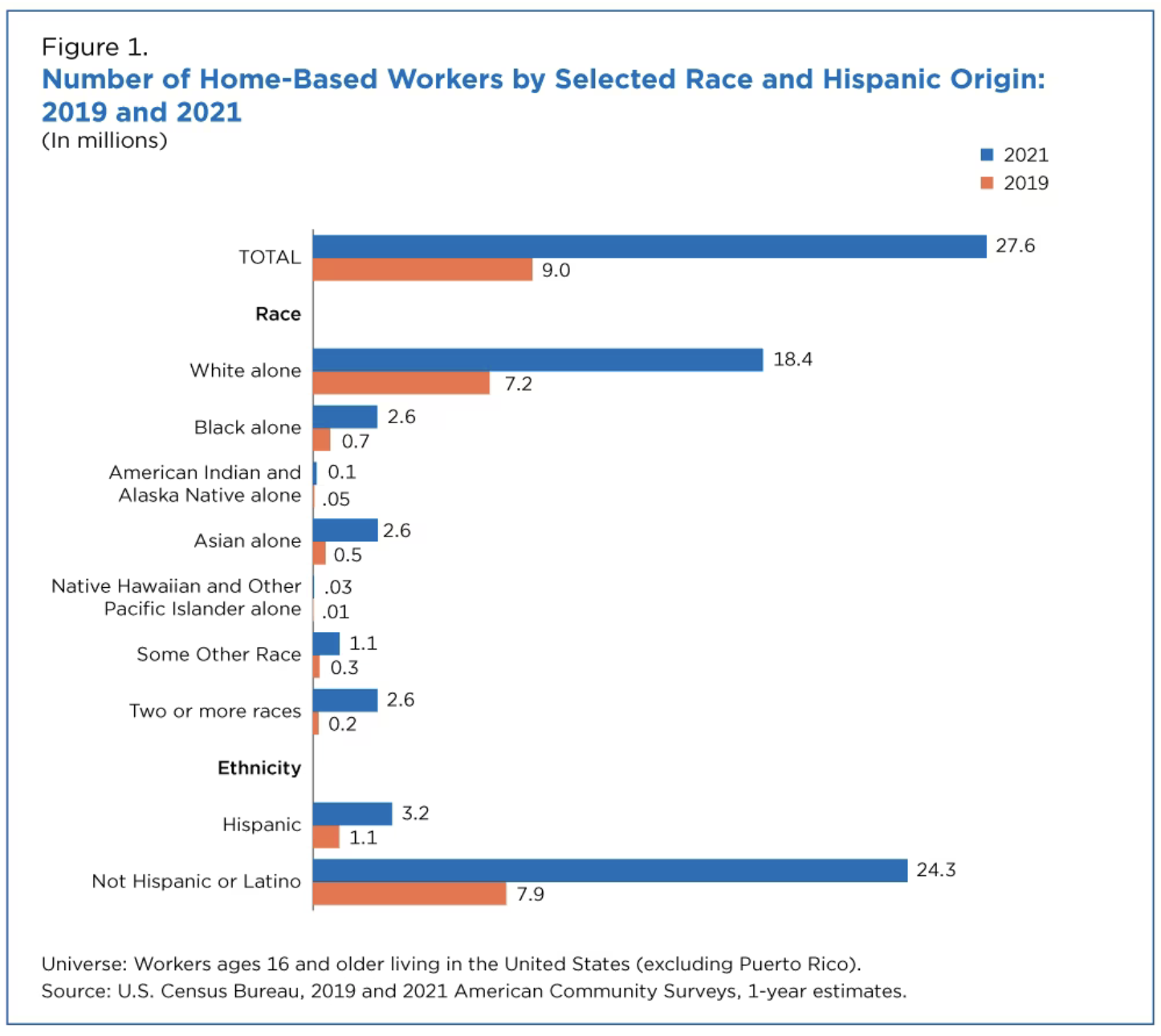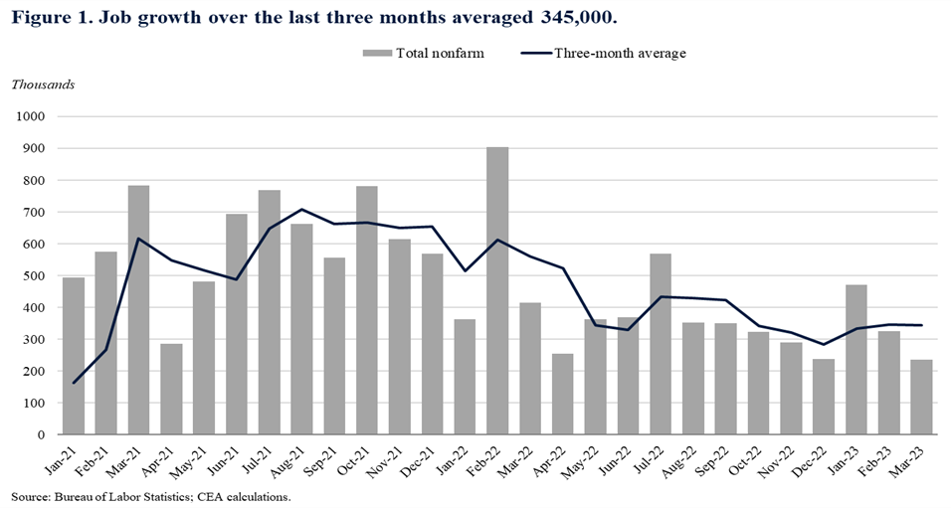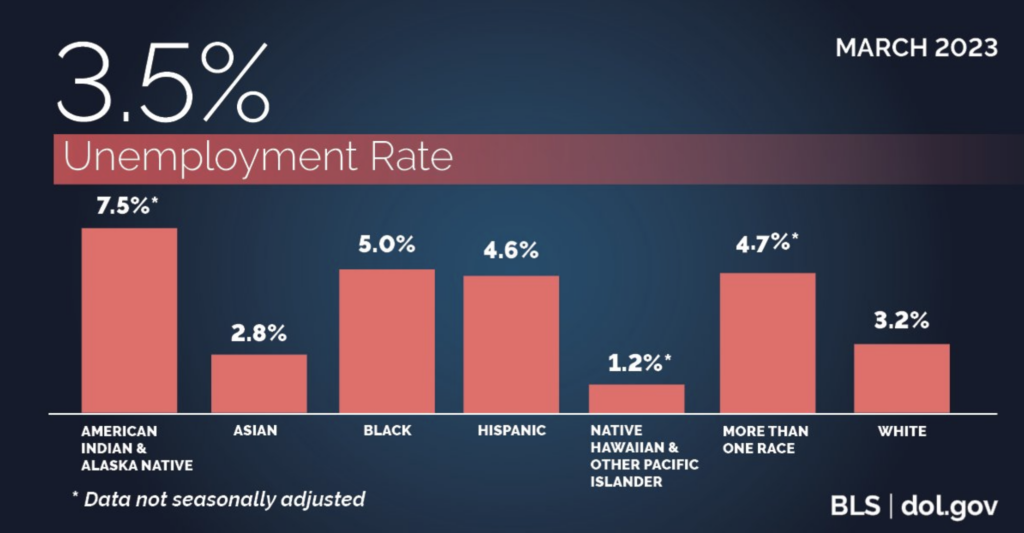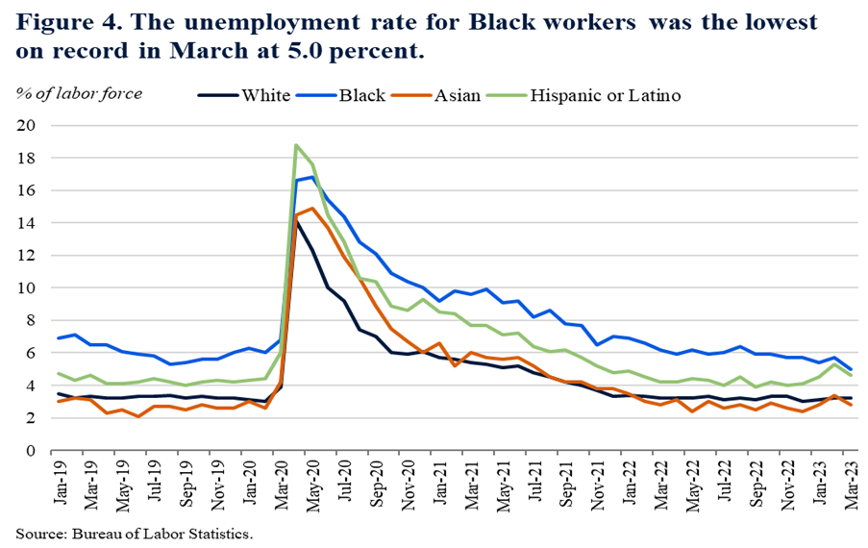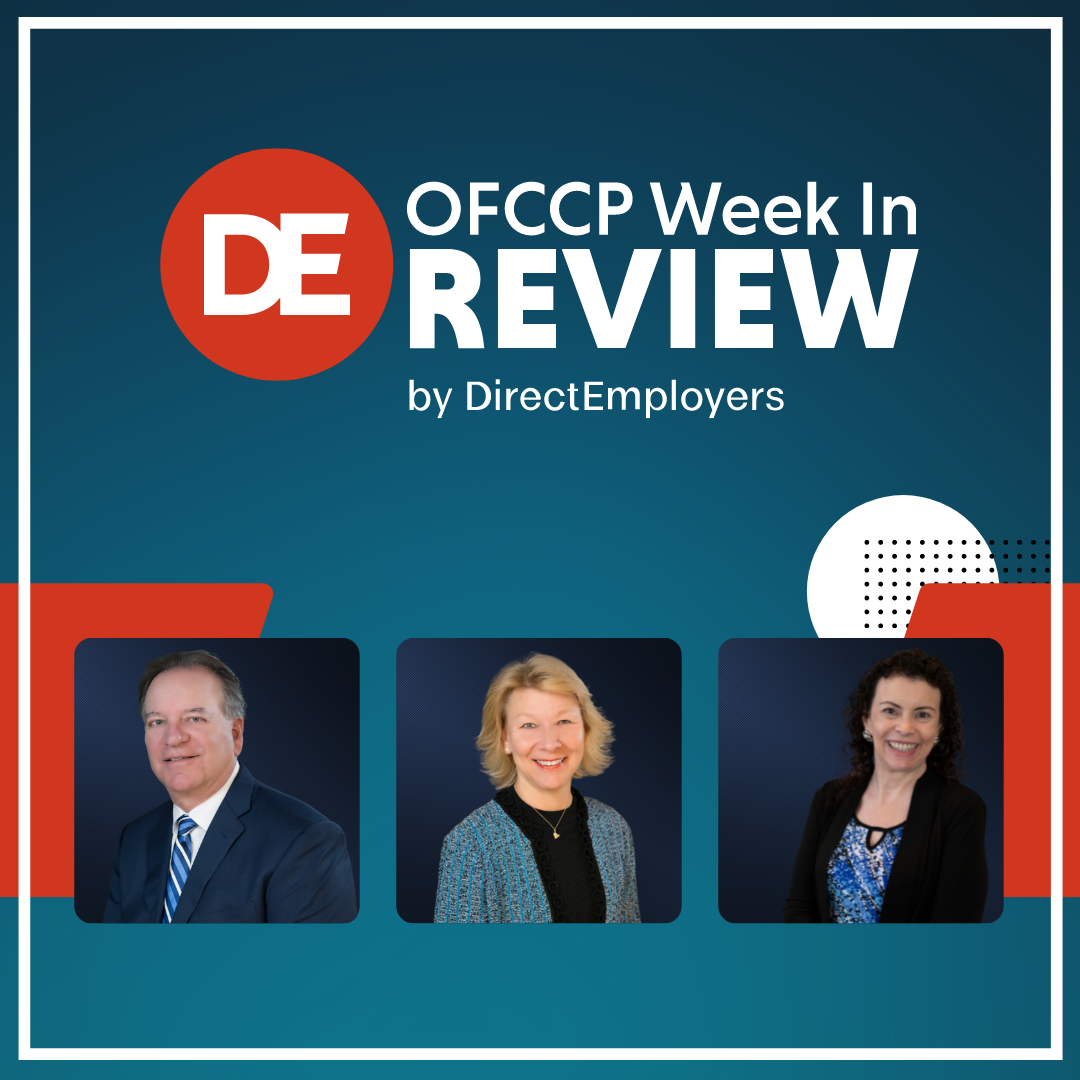
- OFCCP (Silently) Again Updated Its FOIA Objection Portal
- JOLTS Report: Job Openings Decreased by 632k in February, Rate Dropped to 6.0%
- Latest DE Talk Podcast Discussed Building Employee Resource Groups to Create Trustworthy Environments to Encourage ID&E Conversations
- President Biden Issued “Modernizing Regulatory Review” Executive Order
- Substantially More People in All Race/Ethnic Groups Worked from Home Between 2019-2021, U.S. Census Bureau Reported
- Economy Added 236k Jobs in March, Unemployment Rate Decreased Slightly to 3.5%
- In Brief
- Looking Ahead: Upcoming Date Reminders
Tuesday, April 4, 2023: OFCCP (Silently) Again Updated Its FOIA Objection Portal
Agency Intends to Respond to Objections on “Rolling Basis” through September

1. Agency Plans to Address Objections on a “Rolling Basis” Through September
First, on the left side column narrative section, OFCCP added the following new information:
“…For contractors that have objected to the release, OFCCP is evaluating the contents of each objection submitted to determine releasability. Determinations will be made on a case-by-case basis.
Due to the number of objections received and the complexity of the evaluation process, we are unable to give specifics as to when contractors will receive a response to their objection. However, OFCCP intends to respond to objections on a rolling basis through the end of September.” Presumably, this means September 2023.
2. Verifications of Status as Non-Federal Contractor During Relevant Period
Second, OFCCP updated the narrative section of its webpage to note:
“Contractors that objected on the basis that they were not federal contractors during the 2016-2020 reporting year will receive a response from OFCCP verifying their contractor status. […apparently meaning that OFCCP will verify a company’s status as either a covered federal Government contractor or not]. Contractors confirmed to be federal contractors will be given an additional opportunity to object to the release of their entities’ data. For those found not to be federal contractors during the specified reporting period, no further action is needed.”
3. OFCCP Intends to Notify Non-Exempt Contractors Prior to Disclosure
Third, OFCCP updated the narrative section of its website to note:
“Once the evaluation of all objections has been concluded, OFCCP anticipates a supplemental release of EEO-1 data of contractors whose objection did not support the assertion of an exemption. These objecting contractors will be notified of OFCCP’s determination in advance of any disclosure of information. OFCCP will also provide CIR [CIR is the FOIA requestor] a response that includes a list of contractors whose EEO-1 reports were found to be exempt from disclosure.”
4. Due Dates Removed
Fourth, OFCCP removed all due dates in its FAQ section. OFCCP’s most recent due date extension was to March 31, 2023. Yet, curiously, the agency kept in print all the information in the FAQ describing to contractors how to submit an objection (see Question 11).
5. Updated Status Hearing Information
Finally, OFCCP updated the status hearing date listed for the court case to the correct one – April 13, 2023. In our story in mid-March, we noted that:
“Although OFCCP’s Response Portal first stated on February 14 (and continues to state) that “an initial Case Management Conference before Senior Judge William Alsup [was] scheduled for February 16, 2023,” the court’s webpage with the judge’s schedule showed then that this hearing was rescheduled to March 9, 2023. However, currently, the judge’s calendar shows that it is now slated for Thursday, April 13, 2023.”
As of our WIR deadline, the status hearing is still scheduled for April 13.
Tuesday, April 4, 2023: JOLTS Report: Job Openings Decreased by 632k in February, Rate Dropped to 6.0%

Hires (Overall hiring fell off in February, despite a small federal government hiring uptick)
The number of hires decreased to 6,163,000 in February (the rate was 4.0 percent) compared to the adjusted number of 6,327,000 in January (4.1 percent). Hires increased in the federal government (+8,000).
Separations (Involuntary terminations decreased even as more employees quit)
Total separations went down to 5,820,000 in February compared to 5,900,000 in January (adjusted). The rate decreased slightly to 3.7 percent compared to 3.8 percent in January. The number of total separations decreased in transportation, warehousing, and utilities (-45,000) but increased in educational services (+21,000)
Quits increased to 4,024,000 in February compared to the adjusted 3,878,000 number for January (+146,000) and the rate increased slightly to 2.6 percent compared to 2.5 percent in January. Quits increased in professional and business services (+115,000); accommodation and food services (+93,000); wholesale trade (+31,000); and educational services (+18,000). The number of quits decreased in finance and insurance (-39,000).
Layoffs and discharges decreased a bit at 1,504,000 in February (1.0 percent rate) compared to 1,719,000 (adjusted) in January (-215,000). The rate decreased to 1.0 percent compared to January’s 1.1 percent. Layoffs and discharges decreased in professional and business services (-157,000).
BLS posted interactive graphs here.
Three-Month Comparison Chart of Job Openings vs Jobs Filled
Our below table reports the number of available jobs (as taken from the revised JOLTS reports) from the last four months of available data, as revised.
| Reports | November | December | January | February |
|
JOLTS available jobs Prior/mo. comparison |
10,746,000 (275,000 > October*) |
11,234,000 (488,000 > November) |
10,563,000 (671,000 < December) |
9,931,000 (632,000 < January) |
*October Job Openings were 10,471,000
Note: BLS is scheduled to release the JOLTS Report for March 2023 on Tuesday, May 2, 2023.
Tuesday, April 4, 2023: Latest DE Talk Podcast Discussed Building Employee Resource Groups to Create Trustworthy Environments to Encourage ID&E Conversations
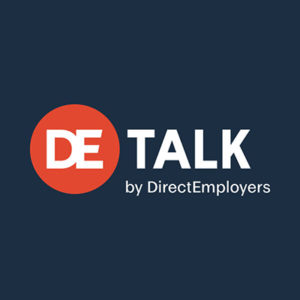
Click here to listen now!
Listen to our DE Talk Podcasts via any of the options below and subscribe to receive updates whenever a new podcast is available.
Apple • Spotify • Google • Stitcher • iHeartRadio • Stitcher • TuneIn • Overcast • Pocket Casts • Castro • Castbox • Podchaser • RSS Feed
…or your preferred Podcast provider!
Thursday, April 6, 2023: President Biden Issued “Modernizing Regulatory Review” Executive Order
Move Expected to Significantly Reduce Number of Regulations Subject to OMB Review
Includes Proposals as to How Federal Agencies May Spend Grant Monies
June 6, 2023 Comment Deadline on Proposed Changes to OMB Circulars A-4 & A-94

Wasting no time, OMB issued proposed Rules, discussed below, contemporaneously with the President’s publication of his April 6 Executive Order. These proposed Rules seek to change key OMB guidance documents prescribing how federal agencies calculate costs and benefits (Circular A-4) and how federal agencies may spend federal grant monies (Circular A-94).
These changes will “focus federal agency and Office of Information and Regulatory Affairs [(“OIRA”)] time and resources where they can have the greatest positive effect,” OIRA Administrator Richard L. Revesz in a corresponding blog.
“Significant Regulatory Action” Parameters
This is important. The new E.O. also increased the economic threshold for a “significant regulatory action” subject to “rigorous” regulatory cost-benefit analyses of those actions that have an annual effect on the economy of $200 million or more (up from the previous $100 million). It also directed the Office of Information and Regulatory Affairs (“OIRA”) Administrator to adjust this threshold for GDP growth every three years.
Note: Learning from Chick-fil-A: As federal regulatory activity has increased, especially in this Administration, we have observed OMB falling further and further behind on its docket. OMB has been suffering MUCH longer intervals between agency submission for approval and OMB disgorging its changes and approvals of agency proposals. One way to catch up is to simply shorten the line at the counter by creating a “drive though lane” (ala Chick-fil-A) and thus reduce the amount of work in line to process. Champagne corks are now popping throughout the federal agencies as they see these changes as giving them permission to take a shortcut to new requirements they wish to impose on their regulated communities. Now, the federal agencies may simply draft proposed Rules of less than $200 Million and will now get a “drive through” OMB approval. The federal agencies will also now chop their regulatory proposals into multiple smaller Rules so as to qualify for the “drive through” lanes at OMB.
President Jimmy Carter (D), a retired Navy nuclear engineer in Admiral Rickover’s nuclear Navy, first ordered up rigorous quantitative cost-benefit analyses after running for President on a platform of shrinking the federal government and getting its budget (then starting a small swell) under control. The federal government agencies, however, have always disliked President Carter’s required cost-benefit analyses. This is because cost-benefit analyses serve as an impediment to making changes to their regulatory enforcement schemes. Moreover, cost-benefit analyses transparently reveal to the public the economic impacts their Rules will have and weigh and balance those costs against the expected benefits from the proposed Rules.
And, at least until the Obama Administration—at which time the White House and Congress first ushered in the current era of unusually large national debts—OMB followed Jimmy Carter’s lead and looked at a federal agency’s economic impact requests as a “fixed pie.” That meant that an agency could not justify a change by suggesting the public incur more cost. Rather, OMB–before 2010–expected the agency proposing to change its regulatory scheme (absent new statutory authorizations which required new staffs and budgets), to give up some existing impact OMB had already approved. In other words, you could rearrange “the pie,” but could NOT enlarge it. (No McDonalds Supersizing allowed!)
For example, in her 2000 Rules installing a major overhaul of OFCCP’s Executive Order 11246 Rules, then OFCCP Director Shirley Wilcher created the concept of an “Organizational Profile” (an organizational chart in effect) as an alternative to OFCCP’s then more detailed and costly “Work Force Analysis.” OMB then allowed Shirley to transfer the projected cost savings to contractors (achieved from use of the “Organizational Profile” in lieu of the “Work Force Analysis”) to enact NEW regulatory requirements burdening federal contractors. For the first time, Shirley required covered federal Government contractors to undertake statistical analyses of hires, promotions and involuntary terminations of employment (so-called “Disparity Analyses” now contained at 41 CFR Section 60-2.17). The “economic impact” OMB had previously allowed OFCCP thus did NOT expand. Rather, OFCCP’s OMB-approved economic impact on contractors just changed as to the driver of the allowable impact.
Today’s OMB allows federal agencies to build bigger “pies” without giving up some existing “burden allocation” OMB has already approved for the agency. The new OMB Proposal would now go further and provide federal Executive Branch agencies an “unlimited spending checkbook” (up to $200 Million). In other words, OMB will, pursuant to the Proposal on the table, now accept agency spending uncritically if (a) it is in line with the President’s priorities, (b) does not interfere with the regulatory schemes of other federal agencies; and (c) does not exceed $200 Million worth of impact per year on the regulated community.
So, What Else Makes a Federal Agency Proposed Rule a “Significant Regulatory Action” Other than that it Must Now Have an Economic Impact of Greater Than $200 Million?
- It is likely to result in a rule that may adversely affect in a material way the economy, a sector of the economy, productivity, competition, jobs, the environment, public health or safety, or State, local, territorial, or tribal governments or communities;
- It creates a serious inconsistency or otherwise interferes with an action taken or planned by another agency;
- It materially alters the budgetary impact of entitlements, grants, user fees, or loan programs or the rights and obligations of recipients thereof; or
- It raises legal or policy issues for which centralized review would meaningfully further the President’s priorities or the principles set forth in the E.O., as specifically authorized in a timely manner by the Administrator of OIRA in each case.
What Does This Mean for Employers and Federal Contractors?
For those regulatory actions that do not meet the above criteria, OMB is going to basically approve uncritically any Rule which does not offer $200 Million or more economic impact on the public. Thus, virtually every OFCCP (and employment law) proposed Rule will now enjoy at OMB a resistance-free “rubber stamp,” other than possibly some Fair Labor Standards Act issues (such as Rules proposing changes to exemptions from overtime and independent contractor status which might exceed $200M of economic impact on those who/which would be affected by the change).
Broader Public Participation
In addition, the E.O. directs the OIRA to take steps to encourage greater public participation, particularly among “underserved communities.” “OIRA has already been engaging with members of the public to seek feedback on ways to improve public participation in the regulatory process, and the executive order will build on this progress,” Administrator Revesz pointed out in his blog.
Proposed Rulemaking Changes in Response to Biden’s Executive Order
OIRA Administrator Revesz also announced via his blog that “OIRA is issuing proposed revisions to its government-wide guidance on regulatory analysis, Circular A-4, to help agencies better account for the full range of benefits and costs of their regulatory actions.“ The April 7 Federal Register notice of that proposal is here. Comments are due by June 6, 2023, and may be submitted here.
Circular A-4 was last updated in 2003. “Among other things, the proposed revisions aim to help agencies better account for the value of future regulatory effects and provide the greatest benefits for the American people,” Revesz wrote. “Specifically, the revision updates the discount rate that translates future costs and benefits into present-day values, provides greater support for analyzing distributional effects, and provides more thorough guidance for accounting for risk and uncertainty.”
Grant Monies Spending Revisions Also Proposed
OMB also proposed revisions to Circular A-94, last revised in 1992, which provides guidance on how federal grant money is spent each year. Circular A-94 guidance is separate from Circular A–4, which covers benefit-cost analysis of regulations, rather than spending. Comments are due by June 6, 2023, and may be submitted here.
Other Relevant & Related Documents
Additional documents relevant and related to the above actions include:
- Administrator Resvesz’s memo to regulatory policy officers at executive departments and agencies;
- OMB’s April 7 Federal Register notice requesting nominations of experts to peer review draft revisions of Circular A-4 – nominations may be emailed to MBX.OMB.OIRA.A4PeerReview@omb.eop.gov (subject line: Peer Review Nomination for Updating Circular A–4) no later than April 28, 2023; and
- OMB’s April 7 Federal Register notice requesting public comments on implementing Section 2(e) of the “Modernizing Regulatory Review” E.O. – submit comments here on or before June 6, 2023.
Thursday, April 6, 2023: Substantially More People in All Race/Ethnic Groups Worked from Home Between 2019-2021, U.S. Census Bureau Reported
White & Higher-Income Workers Most Prevalent Among Home-Based Workers
Minorities made the biggest percentage gains in the transition to remote work
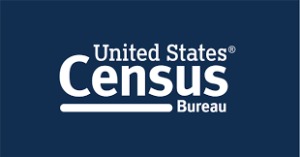
The report, entitled “Home-Based Workers and the COVID-19 Pandemic” used American Community Survey (“ACS”) 1-year estimates to compare teleworking sociodemographic, geographic, and occupational patterns the year before and after the pandemic’s onset.
The 17-page report used multiple tables, graphs, and charts to illustrate its findings. In an announcement about the report, the Bureau noted several racial and ethnic group highlights. The following are those highlights (including our percentage increase calculations rounded to the nearest decimal point):
- White home-based workers increased………………………………..…….155% from 7.2M to 18.4M
- Black home-based workers increased……………………………………….271% from 0.7M to 2.6M
- Asian home-based workers increased……………………………………….420% from 0.5M to 2.6M
- Two or More Races home-based workers increased………………….1,200% from 0.2M to 2.6M
- Hispanic home-based workers increased…………………………………..290% from 1.1M to 3.2M
The following chart from the report further illustrates the above numbers:
Other highlights noted in a separate Census Bureau announcement on the new report included:
- the number and percent of home-based workers more than tripled from 5.7 percent (roughly 9 million workers) to 17.9 percent (about 28 million workers);
- the share of women working from home increased from 50.7 percent of home-based workers in 2019 to 51.3 percent in 2021;
- about 20 percent of workers in the public administration industry, over 36 percent in the professional, scientific, management, and administrative industry, and nearly 40 percent of workers in the finance, insurance, and real estate industry worked from home in 2021;
- among the lowest-earning income decile, the percentage working from home increased from about 6 percent in 2019 to nearly 12 percent in 2021. Within the highest-earning income decile, the percentage working from home rose from about 11 percent to nearly 38 percent. (Note: “decile” = ten equal groups into which a population can be divided according to the distribution of values of a particular variable);
- between 2019 and 2021, the number of people working from home increased in all 50 states, the District of Columbia, and Puerto Rico;
- among the 57 U.S. metro areas with a million or more residents, 11 had 25 percent or more home-based workers in 2021. Five of these 11 metro areas are in the West, four in the South, and one each in the Northeast and Midwest.
What is the ACS?
The ACS is the Census Bureau’s nationwide survey designed to provide timely and reliable data every year on the demographic, social, economic, and housing characteristics of the nation, states, counties, and other localities. For more information on the ACS sample design and other topics, go to the Census Bureau’s ACS webpage.
Friday, April 7, 2023: Economy Added 236k Jobs in March, Unemployment Rate Decreased Slightly to 3.5%
USDOL Touted Record Low Black Unemployment Rate
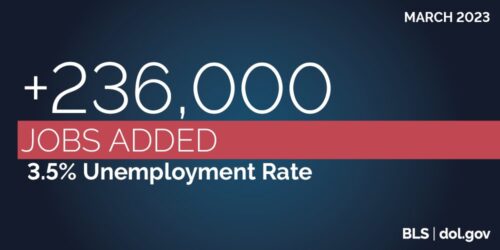
BLS noted that the average monthly job gain over the prior six months was 334,000. March’s showing was thus 30% below the average and almost 150,000 new jobs off January’s blockbuster month (472,000).
The number of unemployed people, at 5.8 million, went down slightly from 5.9 million in February. These measures have shown little net movement since early 2022, BLS observed.
Long-term Unemployment Numbers
Among the unemployed, the number of permanent job losers increased by 172,000 to 1.6 million in March, and the number of reentrants to the labor force declined by 182,000 to 1.7 million. (Note: “Reentrants” are persons who previously worked but were not in the labor force prior to beginning their job search.)
The number of long-term unemployed (those jobless for 27 weeks or more) was little changed at 1,104,000 in March, compared to 1,057,000 in February. These individuals accounted for 18.9 percent of all unemployed persons in March, compared to 17.6 percent in February.
Labor Force Participation
The labor force participation rate, at 62.6 percent, was up a bit from 62.5 percent in February. The employment-population ratio edged up over the month to 60.4 percent, compared to 60.2 percent in February. These measures remain below their pre-pandemic February 2020 levels (63.3 percent and 61.1 percent, respectively), BLS noted.
The number of people employed part-time for economic reasons was essentially unchanged at 4,102,000 in March, compared to 4,067,000 in February.
NOTE TO RECRUITERS: This is a particularly large pool of potential hires (over 4 million workers) who are available to change jobs to convert to full-time work from their part-time positions.
The number of persons not in the labor force who currently want a job was little changed at roughly 4.9 million in March, compared to 5.1 million in February. Among those not in the labor force who wanted a job, the number of persons marginally attached to the labor force was little changed at roughly 1.3 million in March, compared to 1.4 million in February.
The number of discouraged workers, a subset of the marginally attached who believed that no jobs were available for them, also was little changed over the month at 351,000, compared to 363,000 in February.
Major Worker Groups – Black Unemployment Rate at Record Low
“At 5.0% in March, the Black unemployment rate is the lowest rate on record since the series began in 1972. The jobless rate for Black adult women, at 4.2% in March, is also the lowest rate on record since the series began,” the U.S. Department of Labor (USDOL) pointed out in a tweet. The unemployment rate for Hispanics decreased to 4.6 percent in March, essentially offsetting an increase in the prior month, the BLS noted.
The BLS/DOL charts below illustrate the numbers by race and ethnicity:
Our table below compares the major worker groups’ numbers from the last three months of available data:
|
The Employment Situation – March 2023 |
||||
| Unemployment Rate | January 2023 | February 2023 | March 2023 | Feb 2020 Pre-Pandemic |
| National (Seasonally adjusted) |
3.4% | 3.6% | 3.5% | 3.5% |
| White | 3.1% | 3.2% | 3.2% | 3.0% |
| Black | 5.4% | 5.7% | 5.0% | 6.0% |
| Asian | 2.8% | 3.4% | 2.8% | 2.5% |
| Hispanic (Seasonally adjusted) |
4.5% | 5.3% | 4.6% | 4.4% |
| Native Hawaiians & Other Pacific Islanders | 6.2% | 2.8% | 1.2% | 2.7% |
| Two or More Races (Not seasonally adjusted) |
6.1% | 4.9% | 4.7% | 6.1% |
| Men (20+) | 3.2% | 3.3% | 3.4% | 3.2% |
| Women (20+) (Seasonally adjusted) |
3.1% | 3.2% | 3.1% | 3.1% |
| Veteran (Not seasonally adjusted) |
2.8% | 2.5% | 2.4% | 3.7% |
| Individuals with Disabilities (Not seasonally adjusted) |
7.1% | 7.3% | 8.2% | 7.8% |
BLS has additional, interactive graphs available here. Also on Friday, BLS tweeted a link to its December 8, 2017 video on “Understanding BLS Unemployment Statistics.”
See Also:
- President Biden’s remarks
- USDOL Assistant Secretary for Public Affairs Julie McClain Downey’s remarks. (Acting Secretary of Labor Julie Su did not issue a statement.)
- USDOL video short illustrating the report
- White House Counsel of Economic Advisers’ blog
In Brief
Friday, April 7, 2023: Comment Period on Proposals to Overhaul Federal Race & Ethnicity Data Collections Extended to April 27

Last month, the Working Group held three Town Hall meetings to supplement the written public comments it receives. The Working Group’s website has recordings of all three Town Halls available here. It also posted the slide deck for those meetings here.
DirectEmployers will this week file Comments on the Proposals on behalf of its Members.
Looking Ahead:
Upcoming Date Reminders
December 2022: U.S. DOL WHD’s (now overdue) target date to publish a Notice of Proposed Rulemaking to Analyze Public Comments on its proposed rule regarding Nondisplacement of Qualified Workers Under Service Contracts (RIN: 1235-AA42)
December 2022: U.S. OSHA’s (now overdue) target date to publish its Final Rule on Occupational Exposure to COVID-19 in Healthcare Settings (RIN: 1218-AD36) (OSHA submitted this Final Rule to OMB on December 7, 2022)
December 2022: U.S. DOL’s OASAM’s (now overdue) target date to publish Proposed Rule on “Revision of the Regulations Implementing Section 188 of the Workforce Innovation and Opportunity Act (WIOA) to Clarify Nondiscrimination and Equal Opportunity Requirements and Obligations Related to Sex” (RIN: 1291-AA44)
February 2023: U.S. DOL WHD’s (now overdue) target date for its Final Rule on Updating the Davis-Bacon and Related Acts Regulations (RIN: 1235-AA40)
March 2023: OFCCP’s (now overdue) target date for its Notice of Proposed Rulemaking to Require Reporting of Subcontractors (RIN: 1250-AA15)
March 2023: OFCCP’s (now overdue) target date for its Final Rule on Pre-Enforcement Notice & Conciliation Procedures (RIN: 1250-AA14)
March 2023: OFCCP’s (now overdue) target date for its Final Rule on “Technical Amendments” to Update Jurisdictional Thresholds & Remove Gender Assumptive Pronouns (RIN: 1250-AA16)
April 2023: OFCCP’s target date for its Notice of Proposed Rulemaking to “Modernize” Supply & Service Contractor Regulations (RIN: 1250-AA13)
Wednesday, April 12 – Friday, April 14, 2023: DEAMcon23 Chicago (Registrations still open for TWO MORE DAYS (DEAMcon23 starts Wednesday morning!) Agenda available here!)
Wednesday, April 19, 2023: Deadline to submit comments on FTC proposal to ban employers from implementing most worker non-compete agreements (previous March 20 deadline extended) – https://www.regulations.gov/commenton/FTC-2023-0007-0001
Thursday, April 20, 2023 (at 2 pm ET): DE Masterclass Employment Law Roundtable | OFCCP Contractor Portal Issues – Register here
Friday, April 21, 2023: Comments due on OFCCP’s proposed changes to its disability self-identification form (the proposed revised form is here) – https://www.regulations.gov/commenton/DOL_FRDOC_0001-2063
Monday, April 24, 2023: Comments due on USDOL Wage & Hour Division’s Proposal to Revise Existing WD-10 Form for Federal Construction Contractors – https://www.regulations.gov/commenton/DOL_FRDOC_0001-2065
Thursday, April 27, 2023: Comments due on the Office of Management & Budget’s “Initial Proposals for Updating Race and Ethnicity Statistical Standards” (previous April 12 deadline extended) – https://www.regulations.gov/commenton/OMB-2023-0001-0001
Friday, April 28, 2023: Deadline for nominations to OMB of experts to peer review draft revisions of Circular A-4– email nominations to MBX.OMB.OIRA.A4PeerReview@omb.eop.gov (subject line: Peer Review Nomination for Updating Circular A–4)
Sunday, April 30, 2023: Deadline to apply for 2023 HIRE Vets Medallion Award Program – https://www.hirevets.gov
May 2023: U.S. DOL WHD’s target date for its Notice of Proposed Rulemaking on Defining and Delimiting the Exemptions for Executive, Administrative, Professional, Outside Sales and Computer Employees (RIN: 1235-AA39)
May 2023: U.S. DOL WHD’s target date for its Final Rule on Employee or Independent Contractor Classification Under the Fair Labor Standards Act (RIN: 1235-AA43)
Tuesday, May 9, 2023: Public comment deadline on FTC’s “Request for Information” on franchise agreements and franchisor business practices – https://www.regulations.gov/commenton/FTC-2023-0026-0001
Tuesday, June 6, 2023: Comments due on Proposed OMB Circular No. A-4, “Regulatory Analysis” – https://www.regulations.gov/commenton/OMB_FRDOC_0001-0337
Tuesday, June 6, 2023: Deadline for comments due on proposed revisions to OMB Circular A-94 (Guidelines and Discount Rates for Benefit-Cost Analysis of Federal Programs) – https://www.regulations.gov/commenton/OMB-2023-0011-0001
Tuesday, June 6, 2023: Comments due on OMB’s implementation of Section 2(e) of the “Modernizing Regulatory Review” E.O. – https://www.regulations.gov/commenton/OMB_FRDOC_0001-0333
Thursday, June 29, 2023: Deadline for covered federal contractors and subcontractors to certify, via OFCCP’s online Contractor Portal, that they have developed and maintained affirmative action programs for each establishment or functional unit – https://www.dol.gov/newsroom/releases/ofccp/ofccp20230320
August 2023: U.S. NLRB’s target date for its Final Rule on Standard for Determining Joint-Employer Status (under the NLRA) (RIN: 3142-AA21)
August 2023: U.S. NLRB’s target date for its Final Election Protection Rule (RIN: 3142-AA22)
THIS COLUMN IS MEANT TO ASSIST IN A GENERAL UNDERSTANDING OF THE CURRENT LAW AND PRACTICE RELATING TO OFCCP. IT IS NOT TO BE REGARDED AS LEGAL ADVICE. COMPANIES OR INDIVIDUALS WITH PARTICULAR QUESTIONS SHOULD SEEK ADVICE OF COUNSEL.
SUBSCRIBE.
Compliance Alerts
Compliance Tips
Week In Review (WIR)
Subscribe to receive alerts, news and updates on all things related to OFCCP compliance as it applies to federal contractors.
OFCCP Compliance Text Alerts
Get OFCCP compliance alerts on your cell phone. Text the word compliance to 55678 and confirm your subscription. Provider message and data rates may apply.


